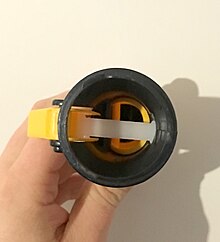Catching cup
Fangbecher , also known as funnel ball or Klick & Fang , is a game of skill for children that probably developed from the French game Bilboquet . Similar ball catching games are also known in other countries under the names Balero, Bilboquet, Perinola, Kendama, Cup and Ball or Ring and Pin. However, the funnel ball catching cup game differs in that the ball is not connected to the fishing gear by a cord.
history
Funnel ball came up in the 1960s, but nothing is known about its origin or inventor. It was probably created as a variant of the much older Bilboquet, which was already very popular in the 16th century. For example, King Heinrich III. from France an enthusiastic bilboquet player and thus contributed significantly to its popularity.
description
Funnel ball consists of a ball and the funnel horn, which in turn consists of a handle and a funnel-shaped catching cup. A shooting mechanism is integrated into the handle with which the ball is transported out of the cup. A trigger is used to apply pressure to a plastic plate, which suddenly curves upwards and thus hurls the ball out of the funnel. Depending on the design and the desired shooting power, the plate can also consist of other materials such as bimetals made of zinc and steel. The funnel itself is mostly made of flexible plastic in order to avoid possible breaks. In order to reduce air resistance, the funnel has holes that vary in size and shape depending on the model. The handle is made of hard plastic in which rubber pads are embedded to prevent slipping while playing. In contrast to conventional cup games, the funnel ball does not have the ball connected to the horn with a string. Depending on the manufacturer, the models vary in shape and color.
Game types
The aim of the game is to catapult the ball into the air with the aid of the catching cup and catch it again. Often the ball is also played against a wall and then caught again. In some cases, the game is also practiced with an opponent who catches the ball with the aid of the cup and returns it.
See also
literature
- Eugen Oker : Games of the World , Fischer TB, 1985, ISBN 3596230748
Individual evidence
- ^ Hellmund GMS. 2001: Jocus, juegos, game, jogo, jeu, giocco, game. Papelera Tolasana SA Buenos Aires. 34p
- ↑ Toys from Back then ( Memento of the original from March 4, 2016 in the Internet Archive ) Info: The archive link was inserted automatically and has not yet been checked. Please check the original and archive link according to the instructions and then remove this notice. .
- ↑ http://www.zeno.org/Pierer-1857/A/Bilb%C5%8Fquet

